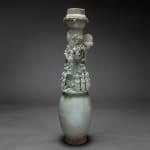Pair of Late Southern Song Q, 1200 CE - 1279 CE
height 82.6 cm
height 32 1/2 in
height 32 1/2 in
NP.019
Further images
-
(View a larger image of thumbnail 1
)

-
(View a larger image of thumbnail 2
)

-
(View a larger image of thumbnail 3
)

-
(View a larger image of thumbnail 4
)

-
(View a larger image of thumbnail 5
)

-
(View a larger image of thumbnail 6
)

-
(View a larger image of thumbnail 7
)

-
(View a larger image of thumbnail 8
)

-
(View a larger image of thumbnail 9
)

-
(View a larger image of thumbnail 10
)

-
(View a larger image of thumbnail 11
)

-
(View a larger image of thumbnail 12
)

After the fall of the Tang Dynasty, a period o unrest and war ensued. The foundation of the Norther Song Dynasty in 960 A.D. and the political unificatio that followed...
After the fall of the Tang Dynasty, a period o unrest and war ensued. The foundation of the Norther Song Dynasty in 960 A.D. and the political unificatio that followed brought these chaotic times to an end. The Song era is considered the third great cultura flourishing of Chinese civilization. Many of th aesthetic elements that now characterize Chines landscape painting were first developed during th Song age. Traditional texts were reanalyzed an reinterpreted, bringing forth a revival o Confucianism peppered with new ideas. The centralize bureaucratic system of the Song replaced th hereditary aristocratic order that had becom entrenched. In 1125 A.D., the Jurchen, a semi-nomadi people from the north, invaded Song China, capture their captial city, and established a dynasty of thei own, the Jin, in the north.
The Song court fled south to Hangzhou where the re-established the Southern Song Dynasty that woul continue to rule for another 120 years. The Son viewed themselves as the culmination of two thousan years of Chinese culture. It is during the Souther Song period when ceramic production in particula reached the height of elegance and technica perfection. Foreign trade fuelled much of the growth o the Southern Song. The Song court had a voraciou appetite for luxury goods imported from abroad,
especially spices from the East Indies. However,
splinters began to emerge among the various ethni groups that had been unified under the Tang. As thes ethnic rivalries grew, the government became fracture after officials began to oppose each other. Left i this weakened state, the Song Dynasty eventuall collapsed after the Mongols invaded and conquere their territory in 1279 A.D.
The Song Dynasty is considered one of the golden age of Chinese ceramics. During the Song era, pottery wa produced en masse for the foreign markets. However,
the finest creations were reserved for a native clas of highly cultivated aristocrats including the rulin elite, high-ranking government officials, and wealth merchants. Technical innovations led to breakthrough in the fields of glazing and firing, culminating i the first true porcelain to be produced in an significant quantity.
Known as QIngbai ware (als called Yingqing ware), this distinctive, blue-glazed, thinly wheel-throw stoneware with moulded and applied decoration was produced mainly in Jiangxi province at Jingdezhen and in the Hebe province. Qingbai ware continued to be made wel into the Ming Dynasty, with Jingdezhen remaining as a important production centre.
The Song court fled south to Hangzhou where the re-established the Southern Song Dynasty that woul continue to rule for another 120 years. The Son viewed themselves as the culmination of two thousan years of Chinese culture. It is during the Souther Song period when ceramic production in particula reached the height of elegance and technica perfection. Foreign trade fuelled much of the growth o the Southern Song. The Song court had a voraciou appetite for luxury goods imported from abroad,
especially spices from the East Indies. However,
splinters began to emerge among the various ethni groups that had been unified under the Tang. As thes ethnic rivalries grew, the government became fracture after officials began to oppose each other. Left i this weakened state, the Song Dynasty eventuall collapsed after the Mongols invaded and conquere their territory in 1279 A.D.
The Song Dynasty is considered one of the golden age of Chinese ceramics. During the Song era, pottery wa produced en masse for the foreign markets. However,
the finest creations were reserved for a native clas of highly cultivated aristocrats including the rulin elite, high-ranking government officials, and wealth merchants. Technical innovations led to breakthrough in the fields of glazing and firing, culminating i the first true porcelain to be produced in an significant quantity.
Known as QIngbai ware (als called Yingqing ware), this distinctive, blue-glazed, thinly wheel-throw stoneware with moulded and applied decoration was produced mainly in Jiangxi province at Jingdezhen and in the Hebe province. Qingbai ware continued to be made wel into the Ming Dynasty, with Jingdezhen remaining as a important production centre.
13
of
13











